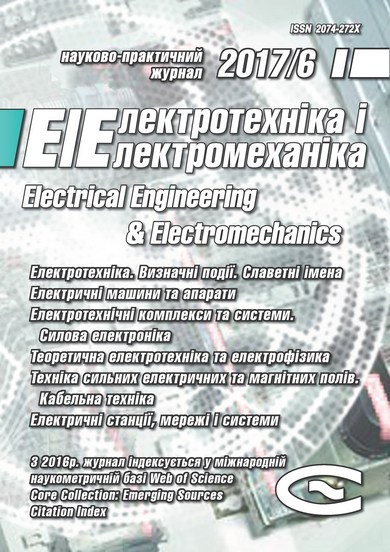AN ANTHOLOGY OF THE DISTINGUISHED ACHIEVEMENTS IN SCIENCE AND TECHNIQUE. PART 41: COMPOSITE MATERIALS: THEIR CLASSIFICATION, TECHNOLOGIES OF MAKING, PROPERTIES AND APPLICATION DOMAINS IN MODERN TECHNIQUE
DOI:
https://doi.org/10.20998/2074-272X.2017.6.01Keywords:
composite materials, basic technologies of receipt of compos, advantages of compos before traditional materials, world achievements in creation of composAbstract
Purpose. Preparation of brief scientific and technical review about the state, achievements and prospects of development of works domestic and foreign scientists-specialists on materials and technologists in area of development and creation of composite materials (compos). Methodology. Scientific methods of collection, analysis and analytical treatment of the opened scientific and technical information of world level in area of studies about materials, related to development of basic technologies of making of new perspective compos and their application in a modern technique. Results. A state-of-the-art scientific and technical review is resulted about the state, achievements and prospects on the future in the world of researches on development and creation of new metallic and non-metal compos, possessing as compared to traditional homogeneous materials substantially more high physical and mechanical descriptions. Classification of compos is executed. Technologies of making of basic types of compos, findings a practical wide use enough in an aviation and space-rocket technique, engineering and row of the special areas of modern technique are briefly described. Main properties of basic types of compos and their advantage are indicated before traditional metals and alloys. The basic failings and technical application for today of different compos domains are resulted. Considerable progress is marked in technologies of making and volumes of the use in the front-rank areas of technique of compos. The possible nearest prospects are indicated in the use of compos on the future in a number of stormy developing in the whole world technical areas. Originality. Systematization of the scientific and technical materials, devoted the basic results of works on being in 2016 year of domestic and foreign specialists in area of development, making and application in the modern technique of the most perspective types of compos, known from the sources opened in outer informative space is executed. Practical value. Popularization and deepening for students, engineers and technical specialists and research workers of scientific and technical knowledges in the necessary area of development, creation and application in the modern technique of compos, extending their scientific range of interests and further development of scientific and technical progress in human society.References
1. Available at: https://en.wikipedia.org/wiki/Composite_material (accessed 13 June 2015).
2. Available at: http://www.e-plastic.ru/main/articles/r2/pk01. (accessed 12 May 2016). (Rus).
3. Piatti J. Dostizhenija v oblasti kompozicionnyh materialov [Achievements in the field of composite materials]. Moscow, Metallurgy Publ., 1982. 304 p. (Rus).
4. Available at: http://www.mtomd.info/archives/1764 (accessed 03 March 2014). (Rus).
5. Vasil’ev V.V. Mehanika konstrukcij iz kompozicionnyh materialov [Mechanics of composite structures materials]. Moscow, Metallurgy Publ., 1988. 272 p. (Rus).
6. Available at: http://stroimsamolet.ru/057.php (accessed 21 October 2015). (Rus).
7. Available at: http://www.hccomposite.com/catalog/40/131 (accessed 10 May 2016). (Rus).
8. Available at: http://www.mtomd.info/archives/1764 (accessed 20 April 2015). (Rus).
9. Available at: http://www.zadachi.org.ru/?n=150240 (accessed 15 August 2014). (Rus).
10. Baranov M.I. An anthology of outstanding achievements in science and technology. Part 13: Nanotechnologies. Electrical engineering & electromechanics, 2013, no.2, pp. 3-13. (Rus). doi: 10.20998/2074-272X.2013.2.01.
11. Available at: http://www.krugosvet.ru/enc/nauka_i_tehnika/himiya/KOMPOZITSIONNIE_MATERIALI.html?page=0,0 (accessed 12 May 2015). (Rus).
12. Available at: http://dic.academic.ru/dic.nsf/ruwiki/367846 (accessed 02 January 2013). (Rus).
13. Available at: http://pentagonus.ru/publ/1976/kompozicionnye_materialy_v_aviastroenii_1976/126-1-0-1942 (accessed 01 May 2013). (Rus).
14. Available at: http://olymp.asclub.ru/publ/raboty_1_go_tura/gotovye_raboty/kak_i_gde_v_samoletostroenii_ispolzujutsja_kompozicion-nye_materialy/6-1-0-825 (accessed 21 September 2015). (Rus).
15. Available at: http://www.spblp.ru/ru/magazine/82/183 (accessed 11 November 2016). (Rus).
16. Available at: http://olgamwill.livejournal.com/5463.html (accessed 18 June 2015). (Rus).
17. Available at: http://rnd.cnews.ru/news/top/index_science.shtml?2012/05/12/489249 (accessed 22 April 2014). (Rus).
18. Baranov M.I. Izbrannye voprosy elektrofiziki. Tom 2, Kn. 2: Teoriia elektrofizicheskikh effektov i zadach [Selected topics of Electrophysics. Vol.2, Book 2. A theory of electrophysical effects and tasks]. Kharkiv, Tochka Publ., 2010. 407 p. (Rus).
19. Baranov M.I., Koliushko G.M., Kravchenko V.I., Nedzel’skii O.S., Dnyshchenko V.N. A Current Generator of the Artificial Lightning for Full-Scale Tests of Engineering Objects. Instruments and Experimental Technique, 2008, no.3, pp. 401-405. doi: 10.1134/s0020441208030123.
20. SAE ARP 5412: 2013. Aircraft Lightning Environment and Ralated Test Waveforms. SAE Aerospace. USA, 2013. − pp. 1-56.
21. SAE ARP 5416: 2013. Aircraft Lightning Test Methods. SAE Aerospace. USA, 2013. − pp. 1-145.
22. Vereshchaka A.S., Tret’yakov I.P. Rezhushchie instrumenty s iznosostojkimi pokrytijami [Tool pieces with wearproof coverages]. Moscow, Engineering Publ., 1986. 192 p. (Rus).
Downloads
Published
How to Cite
Issue
Section
License
Copyright (c) 2017 M. I. Baranov

This work is licensed under a Creative Commons Attribution-NonCommercial 4.0 International License.
Authors who publish with this journal agree to the following terms:
1. Authors retain copyright and grant the journal right of first publication with the work simultaneously licensed under a Creative Commons Attribution License that allows others to share the work with an acknowledgement of the work's authorship and initial publication in this journal.
2. Authors are able to enter into separate, additional contractual arrangements for the non-exclusive distribution of the journal's published version of the work (e.g., post it to an institutional repository or publish it in a book), with an acknowledgement of its initial publication in this journal.
3. Authors are permitted and encouraged to post their work online (e.g., in institutional repositories or on their website) prior to and during the submission process, as it can lead to productive exchanges, as well as earlier and greater citation of published work.





